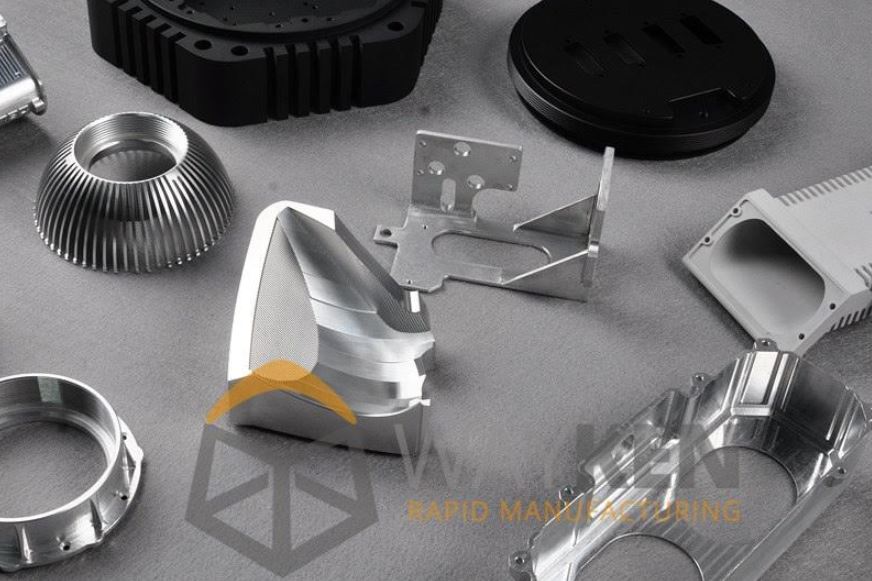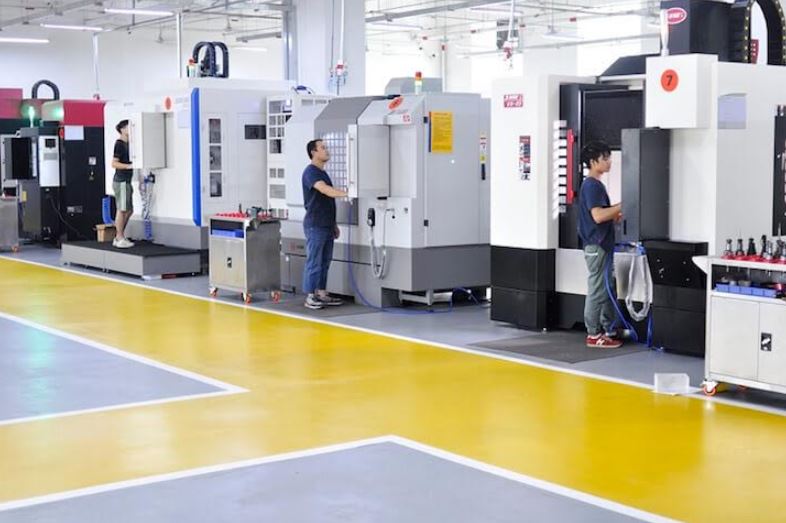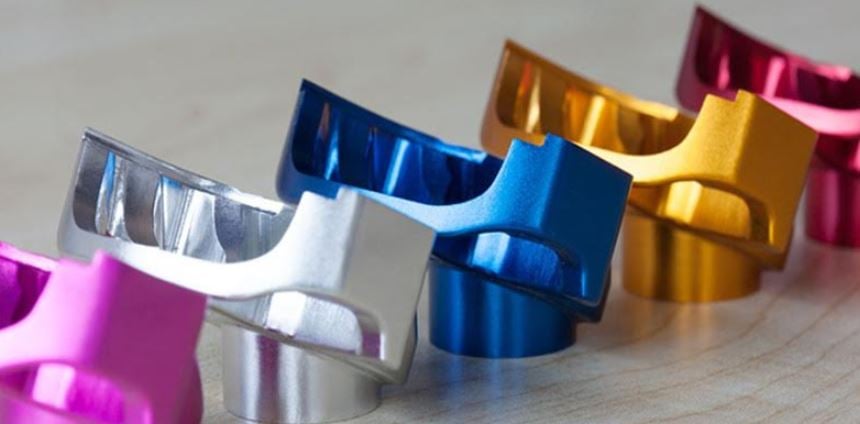
As we know, aluminum is one of the most commonly machined materials featured with excellent machinability. Thus, it has been widely applied in the manufacturing industries. This article, from Wayken, can be your complete guide regarding aluminum machining services and aluminum machining parts, so don’t miss it!
Familiarize with aluminum as a raw material for CNC machining
Being characterized as the second most favorable material for carrying out machining procedures, aluminum makes it to the second position on the list after steel. In terms of machinability and frequency of execution, aluminum is the best raw material for making machine parts.
In general, aluminum is a soft, ductile, and non-magnetic element of the periodic table that carries a silvery-white appearance. This makes it hard to be used in its purest forms. Hence, it is alloyed with various other elements to get the most out of it. The same goes for the process of aluminum machining. Different aluminum alloys are used in the procedure to make the custom machine parts to serve miscellaneous purposes.
Ideal properties of aluminum as a raw material for aluminum machining services
As mentioned above, aluminum is considered one of the best raw materials, and all credit goes to its fundamental properties. Here are some of them that make it worth important.
- Effective machinability makes aluminum a favorable component to be used in CNC machining. It deforms to a lower extent as compared to other materials used during machining. Moreover, due to its soft nature, it can be cut easily and requires less power to be machined. It is cost-effective.
- It carries high strength and less density that makes it favorable to create machine parts that can then be used in aerospace and automotive industries.
- It is corrosion resistant due to which it can be used for the machining process to make parts for the marine industry.
- Aluminum retains all its desirable properties like softness, ductility, and strength even at the lowest of temperatures.
- It is highly recyclable.
Aluminum alloys frequently used in aluminum machining
As mentioned above, aluminum in its pure form cannot be directly employed for aluminum machining services. Hence, it can be alloyed with other materials. Here are five of the top-rated aluminum alloys that are frequently used to make aluminum machining parts.
-
EN AW 2007
An aluminum alloy of copper (4-5%) is highly durable, light, and super functional when it comes to making the custom machine parts. It is best known for its performance in threading, heat treatment, and high-speed machining. It is employed to make machine parts, screws, rivet nuts, and bolts. This alloy carries low grade for weldability; hence, a protective anodizing is required after making the machine parts.
-
EN AW 5083
It is the alloy of aluminum used to make the machine parts that are then used in heavy-duty machines that have to face harsh environments. Along with aluminum, this alloy carries magnesium and traces of chromium and manganese. It is highly resistant to corrosion. But this should not be employed to make parts for the machinery that has to withstand temperature more than 65 degrees. It is vastly used to make the machine part, which then serves cryogenic equipment, marine applications, pressure equipment, chemical applications, welded constructions, and vehicle bodies.
-
EN AW 5754
Being an aluminum alloy containing manganese as the counterpart, it can be easily rolled, forged, and extrude. It carries lower ductility but high-end corrosion resistance. It is one of the best-employed aluminum alloys for aluminum machining services. It is used to craft the machine parts for welded structures, flooring applications, fishing equipment, vehicle bodies, food processing, and rivets.
Procedures carried out in a aluminum machining service shop

When employed to CNC machining, the aluminum alloys pass various processes and end up in the form of custom aluminum machined parts. Here are those processes.
1. Turning process
During the turning operation, the workpiece rotates at breakneck speed while the cutting tool remains stationary on the axis. It further depends on the final product, whether or not the feed motion is required.
2. Milling process
It is the most common process used in aluminum machining. It carries a mufti-point cutting tool rotating along the axis whereas, the workpiece remains stationed. This process is used for material removal and cutting via feed motion.
3. Pocketing
For the parts of machines that need a hollow pocket to fit in, this process of pocketing is carried out. It is a type of CNC milling.
4. Facing
This process is carried out to create a flat cross-sectional area on the machine part via face turning or face milling.
5. Drilling
As the name implies, this process is used to make holes in the machine parts. It carries a multipoint rotating cutting tool for making the holes.
Tool factors important in aluminum machining services
Using appropriate tools is a crucial factor that counts while creating custom machine parts. Here are some essential tool factors that must be considered in the process of aluminum machining.
- Tool flutes
- Helix angle
- Clearance angle
- Feed and speeds
- Cutting fluids
Critical post CNC machining processes used for aluminum machined parts

As soon as the custom aluminum machined part is formed, it has to pass from various post-machining processes to get a final look. Here are some of those post CNC machining processes that are crucial for aluminum machined parts.
1. Bead and sandblasting
It is one of the finishing processes in which glass beads or sand are used with help of a Sand Blasting Machine to create a smooth surface. The process is used for material removal. It gives a matte finish to the machine parts. Other methods include polishing and painting.
2. Coating
As the name implies, the final aluminum machined parts are coated with other materials either to give a finished look or to render a desirable property for end working. The materials used for coating are generally zinc, nickel, and chrome. It is done via electrochemical methods.
3. Anodizing

It is an electrochemical process that coats the exposed parts of machine parts with an aluminum oxide coating. In this process, the final machine part is dipped in the diluted sulphuric acid, and the electric current is applied. This technique is also employed for coloring the machine parts.
4. Powder coating
This process is all about the color polymer powder coating on the final machine part. It can be done via an electrostatic machine gun. This powder coating gives corrosion resistance to the machine parts.
5. Heat treatment
Aluminum machined parts are employed to heat-treatment process for improving their overall mechanical properties.
Industries using the aluminum machined parts
There are several industries which are employing aluminum machined parts. Here are some of them:
- Aerospace industry using the machined aluminum aircraft fittings.
- Automotive industry using shafts made up of machined aluminum.
- Electronic industry using various electronic components and electrical appliances.
- Pharmaceutical and food industry employing machinery with machined aluminum parts that do not react with organic matters.
- Sports industry using machined aluminum in whistles and baseball bats.
As one of the best prototype manufacturers in China, Wayken not only provides prototyping services, but also is dedicated to well serving the global customer. WayKen is also an experienced low volume manufacturer, they can work with you by every step of the way, from prototyping to production. If you want to cooperate with them, don’t hesitate to contact them.
Interesting related article: “What is Manufacturing?“

